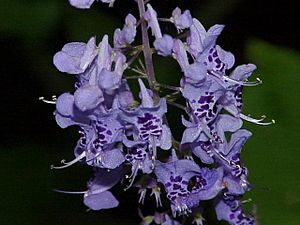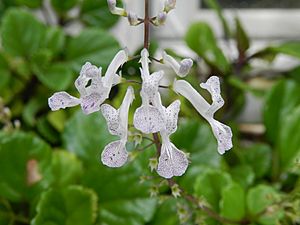Spur-flower facts for kids
Quick facts for kids Spur-flower |
|
|---|---|
 |
|
| Plectranthus fruticosus | |
| Scientific classification |
|
| Kingdom: | Plantae |
| Clade: | Tracheophytes |
| Clade: | Angiosperms |
| Clade: | Eudicots |
| Clade: | Asterids |
| Order: | Lamiales |
| Family: | Lamiaceae |
| Subfamily: | Nepetoideae |
| Tribe: | Ocimeae |
| Genus: | Plectranthus L'Hér. |
| Species | |
|
Many, see text |
|
| Synonyms | |
|
Ascocarydion G.Taylor |
|
Plectranthus is a group of about 85 different kinds of flowering plants. These plants belong to the Lamiaceae family, also known as the mint or sage family. You can find most Plectranthus plants in southern and tropical Africa, as well as on the island of Madagascar. A common name for them is spur-flower.
Most Plectranthus species are herbaceous perennial plants. This means they have soft stems and live for more than two years. Some are annuals, meaning they live for just one year. Others are soft, woody shrubs, and some can even store water like succulents. A few types have a tuberous base, which is a swollen part of the stem or root that stores food.
Many Plectranthus plants are grown as ornamental plants. People love them for their beautiful flowers and leaves. For example, a special type called Mona Lavender has won an award for being a great garden plant. This award is from the Royal Horticultural Society.
Scientists are always learning more about how plants are related. Recent studies have shown that Plectranthus is closely linked to other plant groups like Coleus and Solenostemon. Because of these new discoveries, many plants once called Plectranthus have been moved to the Coleus group. This helps scientists understand plant families better.
Contents
What Does Plectranthus Mean?
The name plectranthus comes from Ancient Greek words. The word plēktron means "anything to strike with," like a spear point or a tool for playing a lyre. The word anthos means "blossom" or "flower." So, the name hints at the shape of the flower.
Many Kinds of Plectranthus Plants
As of October 2022, scientists recognize 84 different species of Plectranthus. These plants grow in various places, mainly in Africa and Madagascar. They can be found in different environments, from sunny plains to shaded forests. Each species has its own unique look and growing habits.
Here are a few examples of the many Plectranthus species:
- Plectranthus fruticosus: Found in southern Mozambique and South Africa.
- Plectranthus ciliatus: Grows in South Africa and Swaziland.
- Plectranthus ernstii: Native to South Africa, from the Eastern Cape to southern KwaZulu-Natal.
- Plectranthus oertendahlii: Found in South Africa, specifically southern KwaZulu-Natal.
- Plectranthus verticillatus: Grows from southern Mozambique down to South Africa.
Plants That Moved to the Coleus Family
Sometimes, as scientists learn more about plants through genetic studies, they find that some plants are more closely related to a different group than previously thought. This means their scientific names might change. In 2019, many plants that were once called Plectranthus were moved into the Coleus group. This helps to make the plant family tree more accurate.
Here are some well-known plants that are now part of the Coleus family:
- Plectranthus amboinicus is now Coleus amboinicus.
- Plectranthus barbatus is now Coleus barbatus.
- Plectranthus caninus is now Coleus caninus.
- Plectranthus esculentus is now Coleus esculentus.
- Plectranthus rotundifolius is now Coleus rotundifolius.
- Plectranthus scutellarioides is now Coleus scutellarioides. This is a very popular plant known for its colorful leaves.
See also
 In Spanish: Plectranthus para niños
In Spanish: Plectranthus para niños


